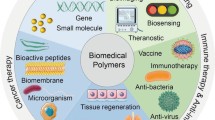Abstract
Recent advances in tissue engineering have leveraged progress in both polymer chemistry and cell biology. For example, photopolymerizable biomaterials have been developed that can be used to photoencapsulate cells in peptide-derivatized hydrogel networks. While these materials have been useful in bone, cartilage and vascular tissue engineering, they have limited applicability to more complex tissues that are characterized by precise cell and tissue organization (e.g., liver, kidney). Typically, the tissue shape has been defined solely by the container used for photopolymerization. In this paper, we describe the use of photolithographic techniques to broaden the capability of photopolymerizable PEG-based biomaterials by inclusion of structural features within the cell/hydrogel network. Specifically, we describe the development of a photopatterning technique that allows localized photoencapsulation of live mammalian cells to control the tissue architecture. In this study, we optimized the effect of ultraviolet (UV) exposure and photoinitiator concentration on both photopatterning resolution and cell viability. With regard to photopatterning resolution, we found that increased UV exposure broadens feature size, while photoinitiator concentration had no significant effect on patterning resolution. Cell viability was characterized using HepG2 cells, a human hepatoma cell line. We observed that UV exposure itself did not cause cell death over the doses and time scale studied, while the photoinitiator 2,2-dimethoxy-2-phenyl-acetophenone was itself cytotoxic in a dose-dependent manner. Furthermore, the combination of UV and photoinitiator was the least biocompatible condition presumably due to formation of toxic free radicals. The utility of this method was demonstrated by photopatterning hydrogels containing live cells in various single layer structures, patterns of multiple cellular domains in a single “hybrid” hydrogel layer, and patterns of multiple cell types in multiple layers simulating use in a tissue engineering application. The combination of microfabrication approaches with photopolymerizable biomaterials will have implications in tissue engineering, elucidating fundamental structure–function relationships of tissues, and formation of immobilized cell arrays for biotechnological applications.
Similar content being viewed by others
References
S.F. Badylak, K. Park, N. Peppas, G. McCabe, and M. Yoder, Exp. Hematol. 29(11), 1310-1318 (2001).
D.J. Beebe, J.S. Moore, J.M. Bauer, Y. Qing, R.H. Liu, C. Devadoss, and J. Byung-Ho, Nature 404(6778), 588-590 (2000).
S.N. Bhatia, U.J. Balis, M.L. Yarmush, and M. Toner, Faseb Journal 13(14), 1883-1900 (1999).
S.N. Bhatia and C.S. Chen, Biomedical Microdevices 2(2), 131-144 (1999).
S.J. Bryant and K.S. Anseth, J. Biomed. Mater. Res. 59(1), 63-72 (2002).
S.J. Bryant, C.R. Nuttelman, and K.S. Anseth, J. Biomater. Sci. Polym. Ed. 11(5), 439-457 (2000).
G. Chen, Y. Imanishi, and Y. Ito, Langmuir 14, 6610-6612 (1998).
G.M. Cruise, O.D. Hegre, D.S. Scharp, and J.A. Hubbell, Biotechnology and Bioengineering 57(6), 655-656 (1998).
G.M. Cruise, D.S. Scharp, and J.A. Hubbell, Biomaterials 19(14), 1287-1294 (1998).
J. Elisseeff, W. McIntosh, K. Anseth, S. Riley, P. Ragan, and R. Langer, Journal of Biomedical Materials Research 51(2), 164-171 (2000).
A.S. Gobin and J.L. West, Faseb J. 16(7), 751-753 (2002).
L.G. Griffith, B. Wu, M.J. Cima, M.J. Powers, B. Chaignaud, and J.P. Vacanti, Ann. N.Y. Acad. Sci. 831, 382-397 (1997).
D.L. Hern and J.A. Hubbell, Journal of Biomedical Materials Research 39(2), 266-276 (1998).
R. Langer and J.P. Vacanti, Science 260(5110), 920-926 (1993).
K.Y. Lee, M.C. Peters, K.W. Anderson, and D.J. Mooney, Nature 408(6815), 998-1000 (2000).
P.X. Ma and R. Zhang, J. Biomed. Mater. Res. 56(4), 469-477 (2001).
M. Madou, Fundamentals of Microfabrication (CRC Press, New York, 1997).
B.K. Mann, A.S. Gobin, A.T. Tsai, R.H. Schmedlen, and J.L. West, Biomaterials 22(22), 3045-3051 (2001).
B.K. Mann, R.H. Schmedlen, and J.L. West, Biomaterials 22(5), 439-444 (2001).
M.B. Mellott, K. Searcy, and M.V. Pishko, Biomaterials 22(9), 929-941 (2001).
N.A. Peppas, P. Bures, W. Leobandung, and H. Ichikawa, Eur. J. Pharm. Biopharm. 50(1), 27-46 (2000).
J.H. Ward, R. Bashir, and N.A. Peppas, J. Biomed. Mater. Res. 56(3), 351-360 (2001).
T.H. Yang, H. Miyoshi, and N. Ohshima, J. Biomed. Mater. Res. 55(3), 379-386 (2001).
T. Yu, F. Chiellini, D. Schmaljohann, R. Solaro, and C.K. Ober, Polymer Preprints 41(2), 1699-1700 (2000).
Author information
Authors and Affiliations
Corresponding author
Rights and permissions
About this article
Cite this article
Liu, V.A., Bhatia, S.N. Three-Dimensional Photopatterning of Hydrogels Containing Living Cells. Biomedical Microdevices 4, 257–266 (2002). https://doi.org/10.1023/A:1020932105236
Issue Date:
DOI: https://doi.org/10.1023/A:1020932105236




